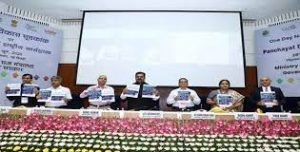Today’s Current Affairs: 4th Jul 2023 for UPSC IAS exams, State PSC exams, SSC CGL, State SSC, RRB, Railways, Banking Exam & IBPS, etc
Table of Contents
Ashadha Purnima : 3rd July 2023

The International Buddhist Confederation (IBC), under the aegis of the Ministry of Culture, will celebrate Ashadha Purnima on July 3, as the Dharma Chakra Pravartana Divas at the National Museum, New Delhi.
- The day is also celebrated as Guru Purnima and it falls every year on the full moon day of the month of Ashadha as per the Indian lunar calendar.
- The day is also celebrated as Esala Poya in Sri Lanka and Asanha Bucha in Thailand.
- The day is remembered for the first teaching of Gautam Budha after attaining Enlightenment to the first five ascetic disciples (pancavargiya) on at ‘Deer Park’, Risipatana Mrigadaya in the present day Sarnath, near Varanasi.
- This day is also aptly observed as Guru Purnima by both Buddhists and Hindus as a day to mark reverence to their gurus.
- This day also marks the beginning of the rainy season retreat for the Monks and Nuns also starts with this day.
- The season lasts for three months from July to October.
- During the season they remain in a single place, generally in their temples dedicated to intensive meditation.
INS Shivaji:

The Marine Engineering Specialisation Course (MESC) at INS Shivaji recently celebrated the graduation of 39 officers, hailing from various naval forces.
- INS Shivaji is an Indian Naval station placed in Lonavala, Maharashtra.
- It homes the Naval College of Engineering which trains officers of the Indian Navy and the Indian Coast Guard.
- Indian Navy already operates a primary damage manipulate simulator Akshat at INS Shivaji to train its officers and sailors on damage manage on a warship at sea.
- Indian Navy’s Nuclear, Biological and Chemical Defence School and Center for Marine Engineering Technology also are also based here.
- INS Shivaji had its humble beginning as replacement for the ‘Stokers’ Training School’ at HMIS Dalhousie, in Naval Dockyard, Bombay.
- Commissioned with the aid of the then Governor of Bombay, Sir John Colville, as HMIS Shivaji on 15 February 1945, it has become INS Shivaji on 26 January 1950.
Pangong Tso Lake : Ramp Up Infrastructure

Three years after the violent clash between Indian and Chinese forces in Galwan both countries ramp up infrastructure on north bank of Pangong Tso.
- Pangong Tso lake is one of the most famous lakes in Leh Ladakh, derives its name from the Tibetan word, “Pangong Tso”, which means “high grassland lake”.
- It is also known as Pangong Lake which is a long narrow, endorheic (landlocked) lake situated at a height of more than 14,000 ft (4,350 meters) in the Ladakh Himalayas.
- It is the world’s highest saltwater lake.
- India holds one-third of the 135 km-long boomerang-shaped Pangong lake.
- One-third of the Pangong Lake lies in India and the other two-thirds in China.
- It is also known to change colours, appearing blue, green, and red at different times.
Ol Chiki Script:

The Prime Minister India for saluting the immortal tribal revolutionaries on Hul Diwas used Ol Chiki script of Santhali language.
- Ol Chiki script was created in 1925 by Raghunath Murmu (1905-1982), writer and teacher from what is Mayurbhanj State (now part of Odisha) in India as a way to write Santhali a Munda language.
- Ol Chiki is also known as Ol Cemet’, Ol Ciki, Ol or the Santhali alphabet.
- It was created as a way to promote Santhali culture.
- The script was first publicized in 1939 at the Mayurbhanj State exhibition.
- Murmu published over 150 books in Santhali in the Ol Chiki script, including novels, poetry, drama, grammars, dictionaries and other information about the language and script.
- Santhali is also written with the Latin, Odia, Bengali and Devanagari alphabets.
- Santhali language is spoken mainly in Jharkhand and West Bengal states in northern India, and also in northwestern Bangladesh, eastern Nepal and Bhutan.
- Hul Diwas : Revolution – began in 1855 two years before the uprising of 1857.
Wildlife Crime Control Bureau : Red Alert To Visit All Tiger Reserves

The Wildlife Crime Control Bureau (WCCB) has issued a ‘red alert’ directing the authorities to visit all tiger reserves.
- Wildlife Crime Control Bureau is a statutory multi-disciplinary body established by the Government of India to combat organized wildlife crime in the country.
- It was constituted by amending the Wild Life (Protection) Act, 1972.
- Nodal Ministry: The Ministry of Environment and Forests.
- Headquarter: New Delhi
- In capacity building of the wildlife crime enforcement agencies for scientific and professional investigation into wildlife crimes and assist State Governments to ensure success in prosecutions related to wildlife crimes;
- It advises the Government of India on issues relating to wildlife crimes having national and international ramifications, relevant policy and laws.
- It also assists and advises the Customs authorities in inspection of the consignments of flora & fauna as per the provisions of Wild Life Protection Act, CITES and EXIM Policy governing such an item.
- It has developed an online Wildlife Crime Database Management System to get real time data in order to help analyse trends in crime and devise effective measures to prevent and detect wildlife crimes across India.
Open Market Sale Scheme For Wheat And Rice:

In response to the Food Corporation of India’s (FCI) imposition of quantity restrictions and denial of states’ participation in the Open Market Sale Scheme (OMSS), states have been exploring alternative methods to procure wheat and rice.
- Open Market Sale Scheme is a program implemented by the FCI to facilitate the sale of surplus food grains, primarily wheat, and rice, from the central pool in the open market.
Revised OMSS Restrictions:
- The OMSS underwent a recent revision with a focus on limiting the quantity that a single bidder can purchase in a single bid.
- Previously, the maximum allowed quantity per bid was 3,000 metric tonnes. However, it has now been reduced to a range of 10-100 metric tonnes.
- The aim of this change is to promote wider participation by accommodating small and marginal buyers.
- By encouraging competitive bids from smaller buyers, the revised OMSS seeks to curb retail prices and create a more level playing field.
- Purpose and Objectives:
- Enhance food grain supply during lean seasons.
- Moderate open market prices and control inflation.
- Ensure food security and availability of grains in deficit regions.
- Facilitate the sale of surplus food grains from the central pool.
- Implementation and Process:
- Conduct e-auctions by the FCI for traders, bulk consumers, and retail chains to purchase specified quantities of food grains at pre-determined prices.
- Allow states to procure additional food grains through OMSS for distribution under the National Food Security Act,2013 (NFSA).
- FCI conducts weekly auctions for the OMSS for wheat on the platform of the National Commodity and Derivatives Exchange Limited (NCDEX).
- NCDEX is a commodity exchange platform in India that provides a platform for trading in various agricultural and other commodities.
Floral And Faunal Database:

The details of new discoveries and new records were released by Union Minister for Environment, Forest and Climate Change adding 664 animal species to its faunal database in 2022, 339 taxa to its flora in India.
Floral and Faunal Database:
- The faunal discoveries are compiled in a publication by Zoological Survey of India (ZSI) titled Animal Discoveries – New Species and New Records 2023,
- The floral discoveries are contained in Plant Discoveries 2022 published by the Botanical Survey of India (BSI).
- India added 664 animal species to its faunal database in the year 2022. These comprise 467 new species and 197 new records i.e species found in India for the first time.
- The country also added 339 new plant taxa – 186 taxa that are new to science and 153 taxa as new distributional records from the country in 2022.
- Among the major fauna species discovered are three new species and one new record of mammals; two new records of birds;
- 30 new species and two new records of reptiles; six new species and one new record of amphibia; and 28 new species and eight new records of fish.
- The mammal species discovered include two species of bats –
- Miniopterus phillipsi, a long-fingered bat, and
- Glischropus meghalayanus, a bamboo-dwelling bat – both from Meghalaya.
- Sela macaque (Macaca selai), a new macaque species discovered in the western and central Arunachal Pradesh and named after the Sela Pass, is also among the highlights of Animal Discoveries 2022.
The new records include:
- Macaca leucogenys, a white-cheeked macaque earlier found in Modog, southeastern Tibet, and sighted in India for the first time in 2022 in West Siang, Arunachal Pradesh.
- Ficedula zanthopygia, the yellow-rumped flycatcher, earlier known from Mongolia, Transbaikal, southern China, Korea, western Japan, and found last year in Narcondam Island of the Andaman archipelago.
- The maximum number of new faunal discoveries has been of invertebrates with 583 species, while vertebrates constitute 81 species.
- Insects dominate among invertebrates with 384 species, whereas fish dominated among vertebrates, followed by reptiles, amphibia, mammals and aves.
- Plant Discoveries 2022’ contains an enumeration of 339 taxa, which have been added to the Indian flora during 2022.
- These comprise 319 species, and 20 infraspecific taxa as new to the Indian flora. Of these, 186 taxa are new to science and 153 taxa are new distributional records from India.
The new discoveries:
- 37% are of seed plants, 29% fungi, 16% lichen, 8% algae, 6% bryophytes, 3% microbes and remaining 1% pteridophytes.
- About 21% of the total discoveries were made from the western Himalayas followed by 16% from the Western Ghats.
- The Plant Discoveries 2022, include 125 angiosperms, one gymnosperm, five pteridophytes, 19 bryophytes, 55 lichens, 99 fungi, 27 algae and nine microbes.
- Among the new genus of plants discovered are Nandadevia Pusalkar, a genus common throughout the foothills and warm outer valleys of the Uttarakhand Himalayas, and Nilgiriella Pusalkar, endemic to the southern Western Ghats of India and distributed in Karnataka, Kerala and Tamil Nadu.
- Among the new records in orchid species, Calanthe lamellosa, earlier recorded in China and Myanmar, and found for the first time in India in the Japfu mountain range in Kohima, Nagaland.
64th Global Environment Facility:

At the 64th Global Environment Facility (GEF) council meeting in Brazil, the governing body approved the disbursement of USD 1.4 billion to accelerate efforts to tackle the climate, biodiversity and pollution crises.
- This is the 2nd work program of the GEF-8 funding period, which runs from 2022 and 2026.
Key Highlights of the Meet:
- The Governing board has approved the establishment of a new fund, the Global Biodiversity Framework Fund (GBFF), to finance the implementation of the Kunming-Montreal Global Biodiversity Framework.
- This fund is crucial as nearly 50% of its resources will be allocated to biodiversity-related work during the GEF-8 period.
- 20% will be allocated to Indigenous Peoples and local communities (IPLCs), 25% to GEF agencies, 36% to SIDS (Small Island Developing States), and 3% to LDCs (Least Developed Countries).
- The allocation for IPLCs will be reviewed two years after the ratification in August, while the allocations for SIDS and LDCs will be reviewed three years after ratification.
Global Environment Facility:
- The GEF was established on the eve of the 1992 Rio Earth Summit.
- It is a family of funds dedicated to confronting biodiversity loss, climate change, pollution, and strains on land and ocean health.
- It has a unique governing structure organized around an Assembly, the Council, the Secretariat, 18 agencies, a Scientific and Technical Advisory Panel, and the Evaluation Office.
Panchayat Development Index Report:

The Union Minister of State for Panchayati Raj released the Report on Panchayat Development Index (PDI) at the National Workshop on Panchayat Development Index in New Delhi.
Key Highlights of the Report on the PDI:
- The pilot project was carried out in four districts of Maharashtra, namely Pune, Sangli, Satara, and Solapur.
- The data collected from the pilot project was used to compile the report of the Panchayat Development Index Committee.
- The pilot study showed that 70% of the panchayats in the four districts of Maharashtra fall in Category C, while 27% are in Category B.
- The report highlights the need for evidence-based planning, resources must be deployed where required for overall development.
Panchayat Development Index:
- The PDI is a composite index that measures the performance of panchayats in achieving the Localization of Sustainable Development Goals (SDGs).
- It provides a holistic and evidence-based assessment of the development status of panchayats, highlighting their strengths and weaknesses.
- The PDI aims to promote the Localization of SDGs by creating awareness among panchayats and stakeholders about their importance.
- It encourages panchayats to adopt best practices and innovations to improve their performance in achieving SDGs.
- The PDI provides rankings for panchayats at different levels, including district, block, and village, based on their overall scores.
- Panchayats are categorized into four grades: D (scores under 40%), C (40-60%), B (60-75%), A (75-90%), and A+ (above 90%).
- The PDI considers nine themes, including poverty-free and enhanced livelihood, healthy village, child-friendly village, water-sufficient village, clean and green village, self-sufficient infrastructure, socially just and secured villages, good governance, and women-friendly village.
Eighth Asian Kabaddi Championship Title:

India emerged victorious in the Asian Kabaddi Championship 2023
- India won the title for the eighth time in nine editions.
- The final took place in Busan, South Korea.
- The Indian kabaddi teams will now set their sights on the upcoming Asian Games in Hangzhou, China, scheduled from September 23 to October 8, 2023.
- The 1st Asian Kabaddi Championship was held in 1980 and was included as a demonstration game in the 9th Asian Games, New Delhi in 1982.
- Kabaddi is best known Indian Traditional Game which basically a combative sport, with seven players on each side; played for a period of 40 minutes with a 5 minutes break (20-5-20).
- The core idea of the game is to score points by raiding into the opponent’s court and touching as many defense players as possible without getting caught on a single breath.
- The All-India Kabaddi Federation was formed in 1950 to look after the promotion of the game.
- The new body, Amateur Kabaddi Federation of India (AKFI) came into existence from 1972 affiliated to Indian Olympic Association (IOA) with a view to popularize the game in India & neighboring countries of Asia.




